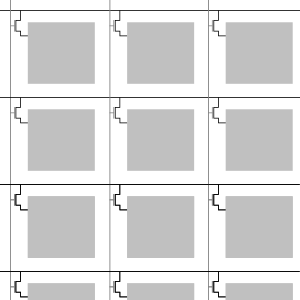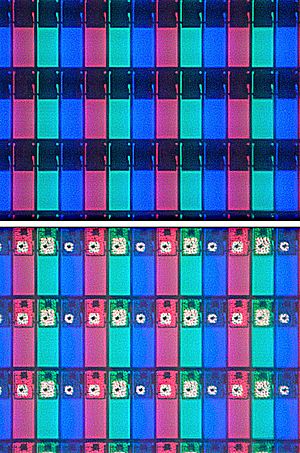TFT LCD facts for kids
A TFT LCD (which stands for Thin-Film-Transistor Liquid-Crystal Display) is a special type of liquid-crystal display (LCD). It uses tiny thin-film transistors to make the picture look much better. These transistors help control each tiny dot of light (called a pixel) on the screen. This makes the picture clearer and the colors more vibrant.
TFT LCDs are "active matrix" displays. This means each pixel has its own tiny switch (a transistor) that turns it on or off. This is different from older, simpler LCDs where groups of pixels shared switches.
You can find TFT LCDs everywhere! They are in your television sets, computer monitors, mobile phones, and video game systems. They are also used in navigation systems, projectors, and even the dashboards of some automobiles and motorcycles.
Contents
How TFT LCDs Started
The idea for the thin-film transistor (TFT) came from J. Torkel Wallmark in 1957. Then, in 1962, Paul K. Weimer at RCA actually built the first TFT.
Later, in 1968, Bernard J. Lechner thought about using TFTs to make a better liquid-crystal display. By 1973, a team at Westinghouse Research Laboratories showed the very first TFT LCD screen.
In 1974, T. Peter Brody and Fang-Chen Luo created the first flat screen that used this "active matrix" idea. Brody even came up with the name "active matrix" in 1975. Today, almost all modern, high-quality screens use this TFT active matrix technology.
How TFT LCD Screens Are Built
Imagine a simple calculator screen. Each number or symbol has its own direct connection. But for a big screen with millions of tiny colored dots (pixels), you can't have millions of wires!
To solve this, screens use a grid system, like a checkerboard. Wires run in rows and columns. Where a row and column meet, there's a tiny transistor switch for each pixel. This switch makes sure that when a pixel gets its power, it holds onto it until the screen refreshes. Each pixel is like a tiny battery (a capacitor) with a special liquid crystal in the middle.
The process of making a TFT LCD is a bit like making computer chips. But instead of using solid silicon wafers, they use a very thin layer of amorphous silicon (silicon that's not perfectly organized) on a glass panel. This silicon layer is put on the glass using a special process. The transistors are very small, so most of the silicon is removed to let light shine through.
Sometimes, a different type of silicon called polycrystalline silicon is used. This is for screens that need to be super clear and fast, like those in projectors. However, amorphous silicon TFTs are much more common because they are cheaper to make.
Different Kinds of TFT LCDs
There are several types of TFT LCD panels, each with its own strengths and weaknesses.
Twisted Nematic (TN) Panels
TN displays are often the oldest and cheapest type of LCD. They are known for being fast, which means less blur when things move quickly on screen. However, they don't show colors as well as other types, and their viewing angles are not great. If you look at a TN screen from the side, the colors can look strange or even change completely.
Many TN panels can only show about 16.2 million colors, not the full 16.7 million colors that computers can create. They do this by using tricks like "dithering" or "Frame Rate Control" (FRC). These methods combine nearby pixels or quickly switch colors to make it look like there are more shades. Some people can notice these tricks, especially in darker colors.
In-Plane Switching (IPS) Panels
In-plane switching (IPS) technology was created in 1996 to fix the problems with TN panels, especially their poor viewing angles and colors. The main difference is how the liquid crystal molecules move. In IPS, they move parallel to the screen, not straight up and down. This helps light pass through better, giving IPS screens wide viewing angles and much better color accuracy.
Early IPS screens were a bit slow and didn't have the best contrast. But newer versions have improved a lot. Because they show colors so well and have wide viewing angles, IPS screens are often used by graphic artists and designers. As they have become cheaper, you can now find them in many regular monitors too.
- S-IPS (Super-IPS) came out in 1998 and improved how fast pixels refreshed.
- AS-IPS (Advanced Super-IPS) from 2002 made the contrast even better.
- AH-IPS (Advanced High Performance IPS) from 2011 improved color, resolution, and used less power.
Advanced Fringe Field Switching (AFFS)
AFFS is a technology similar to IPS. It offers even better performance and colors, with bright images. It helps fix color changes and light leakage, making white and grey colors look more accurate. Hydis Technologies in Korea developed AFFS and has licensed it to other companies like Hitachi.
Multi-Domain Vertical Alignment (MVA)
MVA panels were known for being fast, having wide viewing angles, and good contrast. However, they sometimes had issues with brightness and color. Modern MVA panels have improved a lot, offering good viewing angles (though not as wide as IPS), deep blacks, good colors, and fast response times. If you look at an MVA screen from the side, colors might shift a little, but much less than on TN panels.
Patterned Vertical Alignment (PVA)
PVA panels are similar to MVA. Less expensive PVA panels might use dithering or FRC (like TN panels) to show more colors. But "super-PVA" (S-PVA) panels use at least 8 bits per color, meaning they show true colors without tricks. S-PVA also improved viewing angles and reduced glowing in black areas. These panels can also be very fast with modern technology.
Advanced Super View (ASV)
ASV technology was developed by Sharp. In this type of screen, the liquid crystal molecules are usually straight up and down when the screen is off. When power is applied, they tilt in a special way that creates a continuous pattern, giving excellent viewing angles.
Plane Line Switching (PLS)
Samsung developed Super PLS, which is similar to IPS panels. It offers wider viewing angles, better picture quality, increased brightness, and is cheaper to make. PLS technology first appeared in computer monitors in 2011.
TFT Dual-Transistor Pixel (DTP)
DTP is a special display technology used for things that need very little power, like electronic shelf labels or digital watches. It adds a second transistor to each pixel. This helps the pixel keep its image for a longer time (like 1 second) without needing to be refreshed constantly. By refreshing much slower (1 time per second instead of 60 times per second), DTP saves a lot of power.
Who Makes TFT LCD Panels
Building factories to make TFT LCD panels is very expensive. Because of this, only a few big companies around the world produce the main glass panels for these displays. Some of the major companies include:
- Panasonic (known for IPS-Pro panels)
- LG Display (makes H-IPS and P-IPS)
- AU Optronics (makes A-MVA and A-HVA)
- Chi Mei Optoelectronics (makes S-MVA)
- Samsung (makes S-PVA)
- Sharp (makes ASV and MVA)
These companies also make other types of TFT panels for phones, monitors, cars, and other devices.
How Screens Connect to Devices
Most external screens you use, like computer monitors, have ports like VGA, DVI, HDMI, or DisplayPort. Inside the screen, there's a special board that takes the video signal from your computer or game console and changes it into the digital signal the screen's pixels understand.
For laptops, the computer's graphics chip sends the signal directly to the built-in screen. There's also a way to control how bright the screen's backlight is, usually by changing a voltage or using a special pulsing signal.
Safety of Liquid Crystals
Scientists regularly test the liquid crystals used in these displays to make sure they are safe. Here's what they've found:
- Wastewater from making them can be harmful to water creatures.
- In rare cases, they might cause skin irritation.
- They are not known to cause changes in genes (mutations) or cancer.
- They can be harmful to water organisms like fish.
- They don't build up much in living things.
- They don't break down easily in nature.
The main companies that make liquid crystals have agreed not to sell any that are acutely toxic or cause genetic changes. These companies make up over 90% of the world's liquid crystal supply.
Also, many older LCD monitors use CCFL (Cold Cathode Fluorescent Lamp) backlights, which contain mercury. Mercury is a toxic element.
See also
 In Spanish: TFT LCD para niños
In Spanish: TFT LCD para niños
- Burst dimming
- Computer monitor
- Display examples
- LED display
- Liquid crystal
- Liquid crystal display television
- Transflective liquid crystal display, for adaptation to environment brightness



